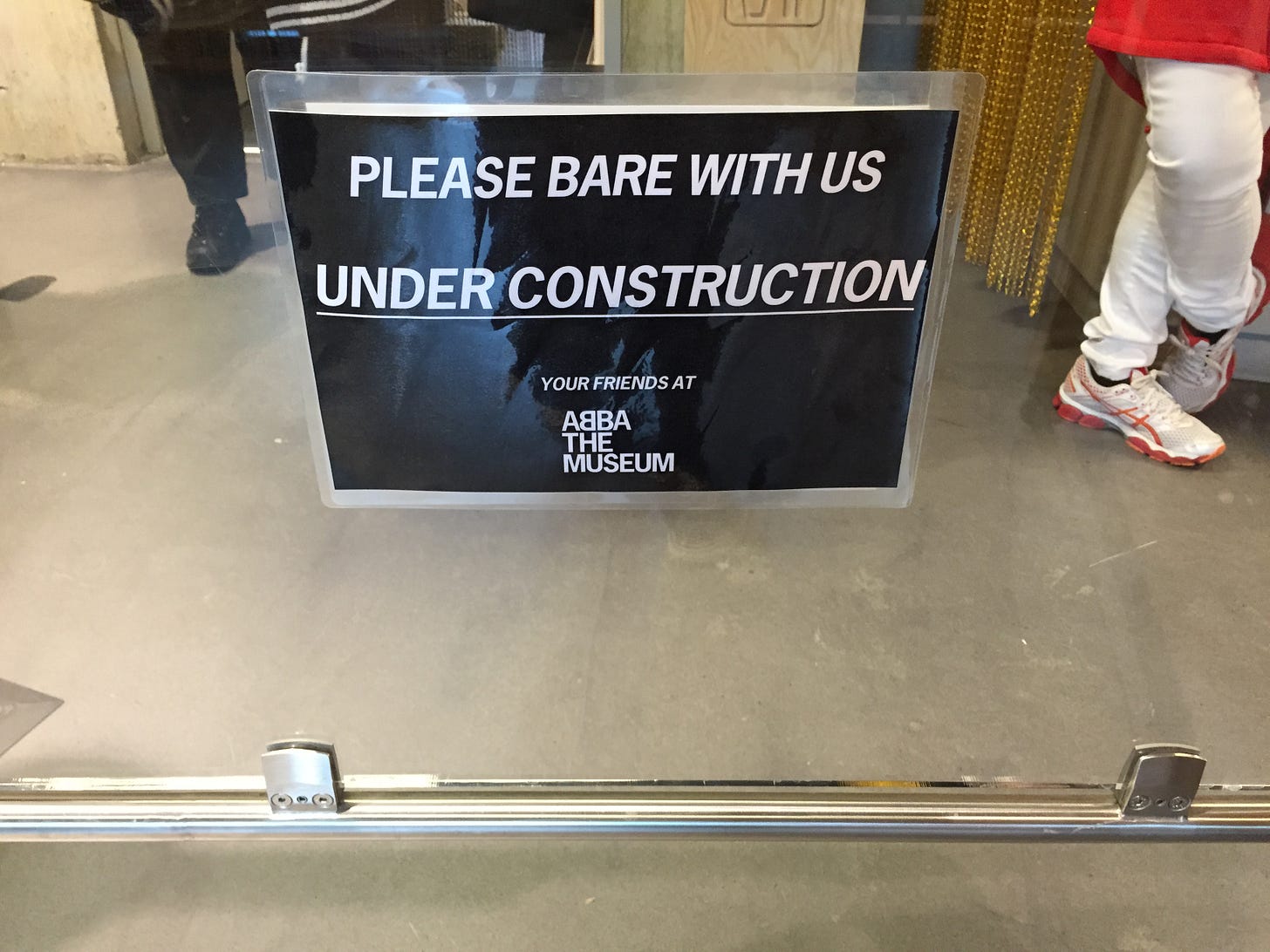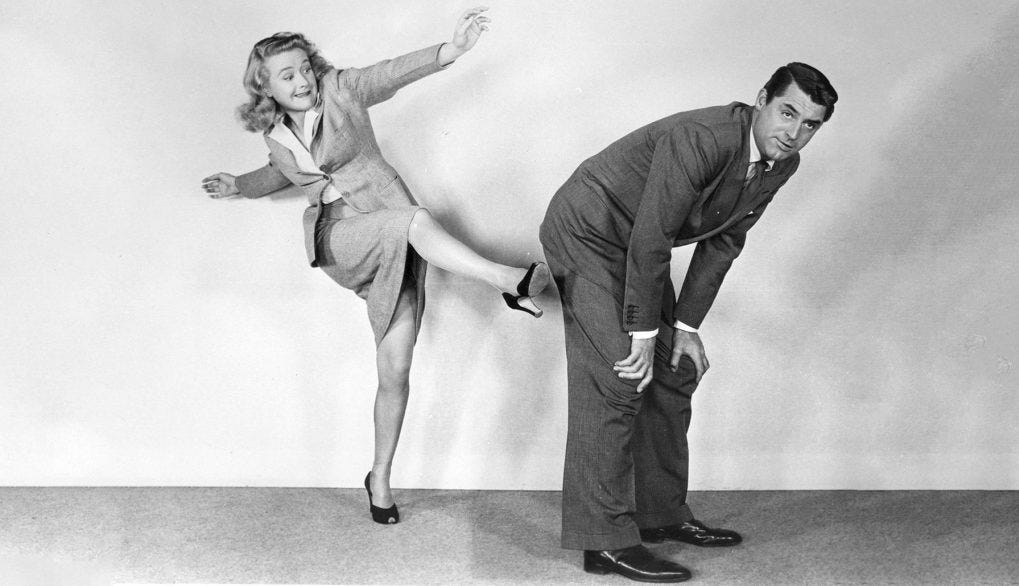As an editor, there are a few common mistakes that never fail to raise a smile (in the best possible way). And this one is probably at the top of the list:

Ah, the confusion over whether to use “bear” or “bare”.
Seeing a sign like this instantly brings Kenneth Williams to mind, in full “Oooh, Matron” glory.

I can see the problem. People think that it couldn’t possibly be “bear with us” or “bear in mind” because they think of the animal. But asking someone to “bare with me” can get you into a whole lot more trouble (and potentially a restraining order to boot).
How to remember which one to use, though?
Well, both words can be used as verbs, but only “bare” can be used as an adjective (“The job paid the bare minimum.”).
As a verb, “bear” means to carry, to support, to endure. “Bare” as a verb means to uncover.
“Bear” and “bare” are homophones, which means they sound the same but have different meanings. The English language is littered with homophones: Two, too and to; you’re and your; they’re, their and there; who’s and whose; it’s and its – the list goes on.
I’ve written about one of these tricky groups in a past newsletter, but I thought I’d now ask you which ones you find the hardest? Which throw you off course each time?
What I’ve read and enjoyed recently
I already knew that I wanted to read Caitlin Moran’s new book, More Than A Woman. But when I heard this passage from it, made me shout out, “Yes!”.
“Even a partner who does 40% of the childcare and household … 40%, that’s nearly half. That’s leaving 10% of their shit for you to sort out. Their trousers to wash, their kids to raise, their meals to prepare. Here’s what that would look like if it were a picture. A woman pulling a sledge on which was her career and her children with her partner occasionally jumping on 10% of the time to chill. This is why of all the things that young women say, “I’m into bad boys or girls” makes older women wince as hard as if they had just said, “I’m into heroin”. No girls, do not want a bad boy or girl. If you find yourself saying that, go and get CBT right now. Or else say it out loud “I formally renounce all my plans for career and happiness in order to marry the wrong person and spend all my time feeling tired”. Because if she wants children and a job, a woman’s life is only as good as the man or woman she marries… All too often, women marry their glass ceilings.”
I am now expectantly waiting for my copy to arrive.
Some spooky lunar activity just in time for Halloween.
Did the Aurora Borealis have a hand in the sinking of the Titanic?
This article spells out all the reasons why GoodReads is so frustrating. It prompted me to sign up for The StoryGraph immediately. I have not been disappointed so far. I really appreciate the analytics and found it especially interesting that I seemingly enjoy slow-paced books that are reflective, informative, emotional, challenging, and dark. In fact, it identified that hopeful and relaxing books are ones I read the least. I think this speaks volumes.
What I have been up to recently
These past few weeks, I’ve been thinking a lot about inspiration and how to find it, prompted by discovering two great sources recently.
Back in September, Anna Codrea-Rado wrote in The Professional Freelancer newsletter about Writers’ Hour – a daily Zoom meeting hosted by the London Writers’ Salon. On each call, you follow Neil Gaiman’s rule of writing or doing nothing (and nothing else) for 50 minutes. Your camera is on, so you feel accountable; there is a positive peer pressure to get something on the page. And it works – for example, I’ve written this now while on the morning call.
I’ve joined for most mornings since I signed up in late September and each time, it has kick-started my day in the best possible way. The timing (9 am for me) is ideal. The boys have left for school, my husband has just left for work, and I have made myself a coffee.
After the 50 minutes is up, I feel motivated to carry on writing. That positive peer pressure continues, beyond the video call.
The second source of inspiration has been a little more specific to me as a writer. I joined a small online workshop called Pitching SOS, run by Heidi Scrimgeour and Hazel Davis from The Muse Flash. They offered some excellent tips for pitching and then opened the discussion up. They picked up on one comment that I posted – that I need a kick in the pants to get pitching again. They got to me to explain a little more about my situation, and they were able to give me some super advice.
I pitched the very next day using their advice. I got a reply from the editor on the same day. Alright, it was a rejection from her. But she said she had forwarded my pitch on to the digital team, keeping it in play. Well, any response feels like a victory these days, so even this news thrilled me.
And then, the next morning, a Friday, I was contacted by the Online Ski Editor, asking for 800 words by Monday morning. Yes, I got a commission, and from The Telegraph, no less. Political leanings aside, I am just thrilled to have been published on the website of one of the UK’s biggest broadsheets: The underrated ski destination that could be your best bet this winter.
I also feel excited about pitching again, thanks to the workshop. I have ideas and plans, which hasn’t happened for a while. I felt so deflated about writing over the spring and summer. That feels like it’s starting to turn around now.
Inspiration is key to our creativity (and it hasn’t gone unnoticed by me that one of my sources of inspiration is called The Muse Flash). Without inspiration, we feel flat, uninventive, dull. Sometimes, though, our familiar old sources are not enough. We need something new; we need to try something different. We need to step out of our comfort zone. We just need that push to do so. We need a kick in the pants.

- - - - - - -
One strange idea that I have developed after needing to produce an article in less time than I am used to has been that “real writers” can produce text that flows beautifully and effortlessly onto the page. In my head, I am not a “real writer” because I have to spend time crafting, reworking and rewriting my words. I know, deep down, that makes absolutely no sense. As an editor (albeit not for a publication), I know just how much time I spend moulding other people’s work. But this thought persists.
I suppose I need something to fixate on and worry about after my successful pitch. Why not this?
- - - - - - -
Here’s to regaining confidence and giving ourselves a kick in the pants when we need it.
Until next time,
Kat




